News
Texas Leaders Worry That Bitcoin Mines Threaten to Crash the State Power Grid
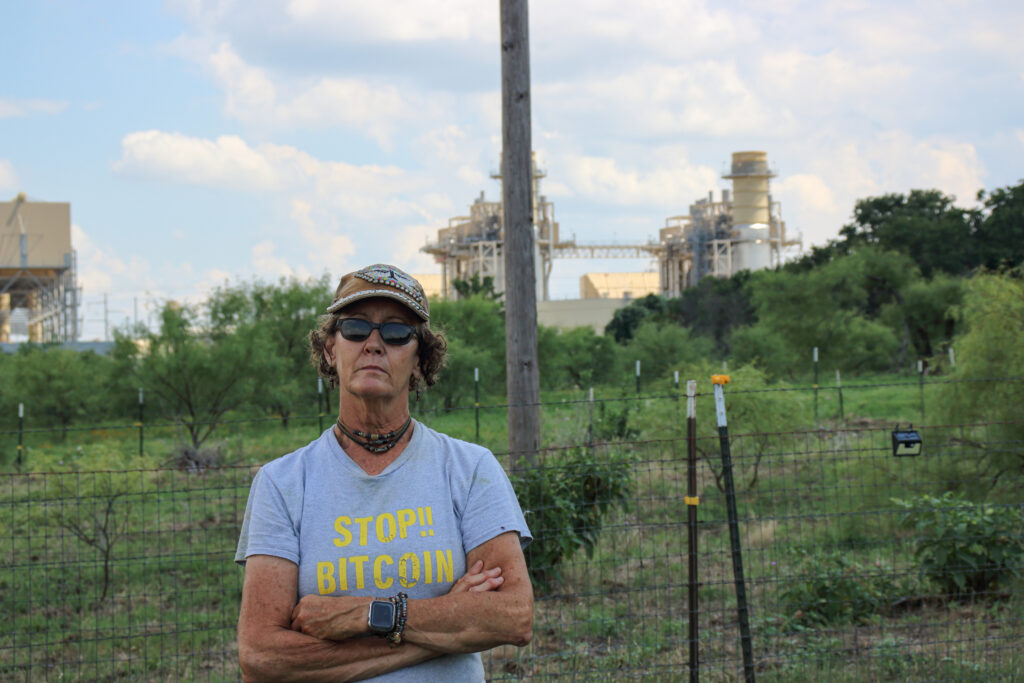
GRANBURY, TEXAS — Cheryl Shadden cannot sleep. The 61-year-old nurse, who works at hospitals giving patients anesthesia, says she is kept up at night by the nonstop mechanical whir of fans spinning to cool tens of thousands of computers.
Shadden lives in Granbury, Texas, about 40 miles southwest of Fort Worth, with her seven dogs, six horses, six cats and a parrot. In 2022, after 23 years in the area, Shadden got a new neighbor: a 300-megawatt Bitcoin facility, referred to as a “mine,” where computers run around the clock to help maintain a global network of transactions in the cryptocurrency.
“Nobody in their right mind would live here,” Shadden said. “My windows rattle. The sound goes through my walls. My ears ring, 24/7.”
Since the facility opened, Shadden said her animals are restless, and some of her dogs have pulled out their own fur. In late June, Shadden went to a doctor to get her hearing examined, and tests found she had suffered permanent hearing loss. She believes her animals’ behavior and her hearing loss were caused by the noise from the Bitcoin mine.
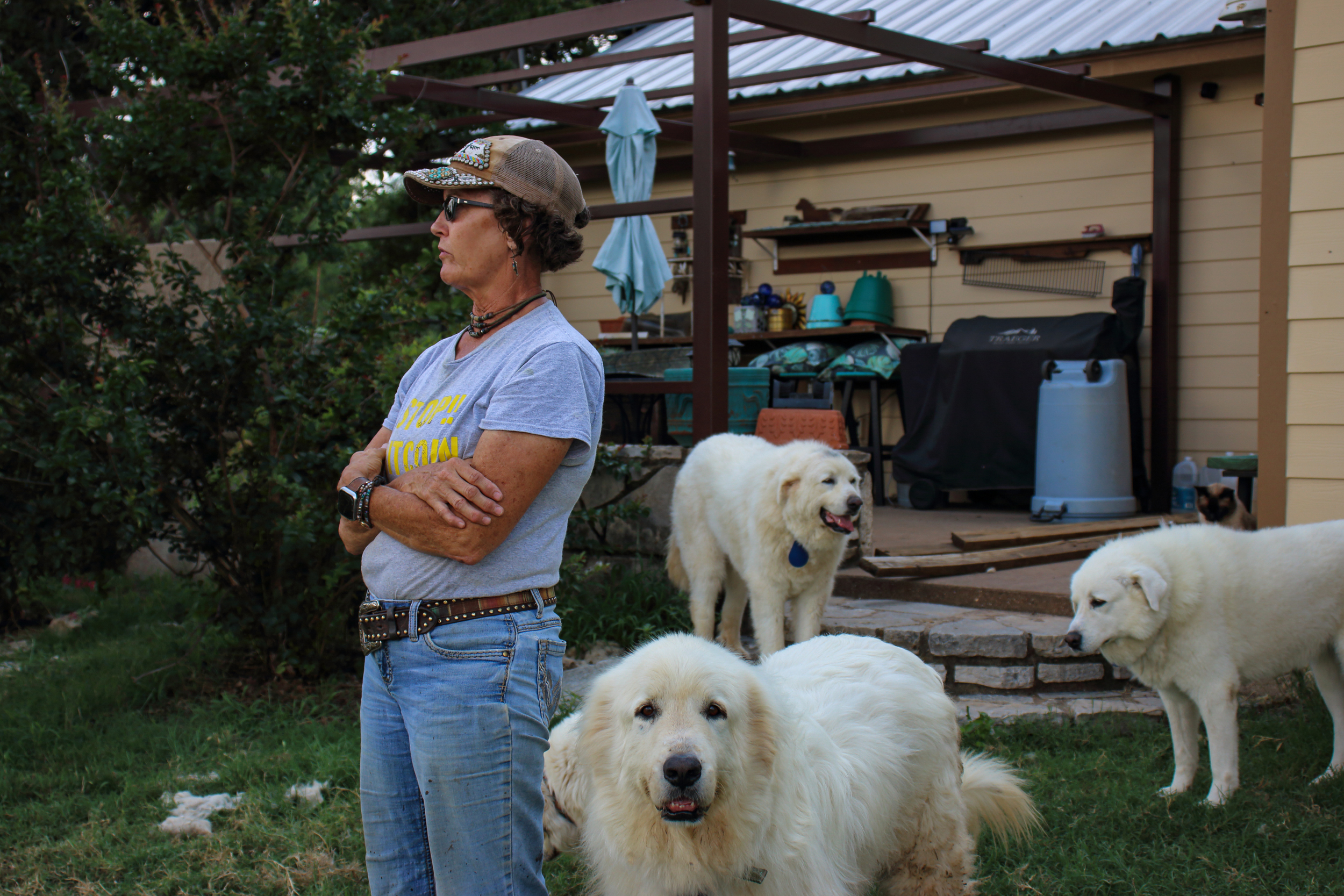 Cheryl Shadden stands in her backyard with several of her Great Pyrenees dogs. Credit: Keaton Peters/Inside Climate News
Cheryl Shadden stands in her backyard with several of her Great Pyrenees dogs. Credit: Keaton Peters/Inside Climate News
Noise pollution is not the only reason that Bitcoin mining may be keeping Texans up at night. The mine owned and operated by Marathon Digital is part of a growing tide of cryptocurrency mining facilities opening across the country, but especially in Texas, where taxes are low, land is plentiful and mining companies can take advantage of the state’s deregulated energy market. As electricity demand rises, ordinary Texans can end up paying the price on their monthly utility bills.
Bitcoin is the largest and best known cryptocurrency, first devised in 2008 as an electronic payment system that cuts out middlemen like banks and credit card companies, with all transactions managed by a decentralized network of Bitcoin users. A Bitcoin, currently worth about $58,000, can be purchased with dollars at a Bitcoin exchange, like Coinbase. To buy something with Bitcoin, a buyer sends the currency from a digital wallet to the seller’s digital wallet.
But it’s not that simple. A computer algorithm assigns each transaction a unique random identifying code, which must be guessed in order to validate the transaction. Bitcoin “mining” comes when companies operate powerful computers day and night running endless series of random numbers before hitting upon, or guessing, the correct code. Every time a Bitcoin miner’s computer successfully guesses a transaction code, the miner receives 3.125 newly minted Bitcoins (worth about $181,250 at the current price), which is the fee for helping maintain the network and keep it secure.
Explore the latest news about what’s at stake for the climate during this election season.
The system is designed so that it takes an average of 10 minutes for a Bitcoin miner somewhere in the world to guess a code and verify a transaction. But as Bitcoin miners add computing power to verify more transactions, the system’s algorithm makes the process harder by generating longer codes, creating what has been called an energy arms race, requiring larger and larger amounts of electricity to run the computers.
Texas is now home to 10 of 34 large Bitcoin mines.
During cold spells or heat waves, Texans are commonly called on to conserve power. For example, in August 2023, the state’s grid operator issued eight conservation requests, asking the public to reduce electricity use to help prevent an emergency in which rolling blackouts could be required. Increasingly, Texas lawmakers are worried that energy-hungry mines will make it harder to keep the lights on across the state.
“They’re going to put our grid at risk because of the power they’re drawing,” said state Sen. José Menéndez (D-San Antonio) at a public hearing on June 12.
For more than six hours, senators on the Business and Commerce Committee pressed grid operators, public utility commissioners and representatives from industries, including manufacturing, oil and gas and cryptocurrency. Chief among legislators’ concerns was the massive growth in energy demand on the state’s main electrical grid, which is estimated to go from a peak demand of about 85,000 megawatts last year to 150,000 megawatts in 2030, according to estimates from the Electric Reliability Council of Texas.
Following the hearing, in a post on social media, Lt. Gov. Dan Patrick declared, “it can’t be the Wild Wild West of data centers and crypto miners crashing our grid and turning the lights off.”
Power Plant Loans and “Large Flexible Loads”
Currently, cryptocurrency mining — mostly for Bitcoin — can draw up to 2,600 megawatts of power from the grid operated by the Electric Reliability Council of Texas, ERCOT’s senior vice president, Woody Rickerson, told senators. That’s about the same amount of power used by the city of Austin, and another 2,600 megawatts of mining is already approved to connect to the grid. Even more Bitcoin mines are expected to come to Texas in the near future.
ERCOT estimates that as much as 43,600 megawatts of additional electricity demand will be added to the grid by 2027 from facilities classified as “Large Flexible Loads” requiring more than 75 megawatts. In a statement to Inside Climate News, ERCOT said, “currently, the crypto mining industry represents the largest share of large flexible loads seeking to interconnect to the ERCOT System.” Data centers for artificial intelligence and facilities for producing hydrogen from water through electrolysis also make up part of the large flexible loads.
To meet the major growth in demand, driven in large part by Bitcoin mining, Texas is turning to natural gas power plants, with taxpayers providing the down payment. In 2023, the Texas legislature passed a loan program, later approved by voters as ballot Proposition 7, to give low-interest loans to companies to build or expand power plants. At first, the Texas Energy Fund will have $10 billion to award, after receiving more than $39 billion in requests.
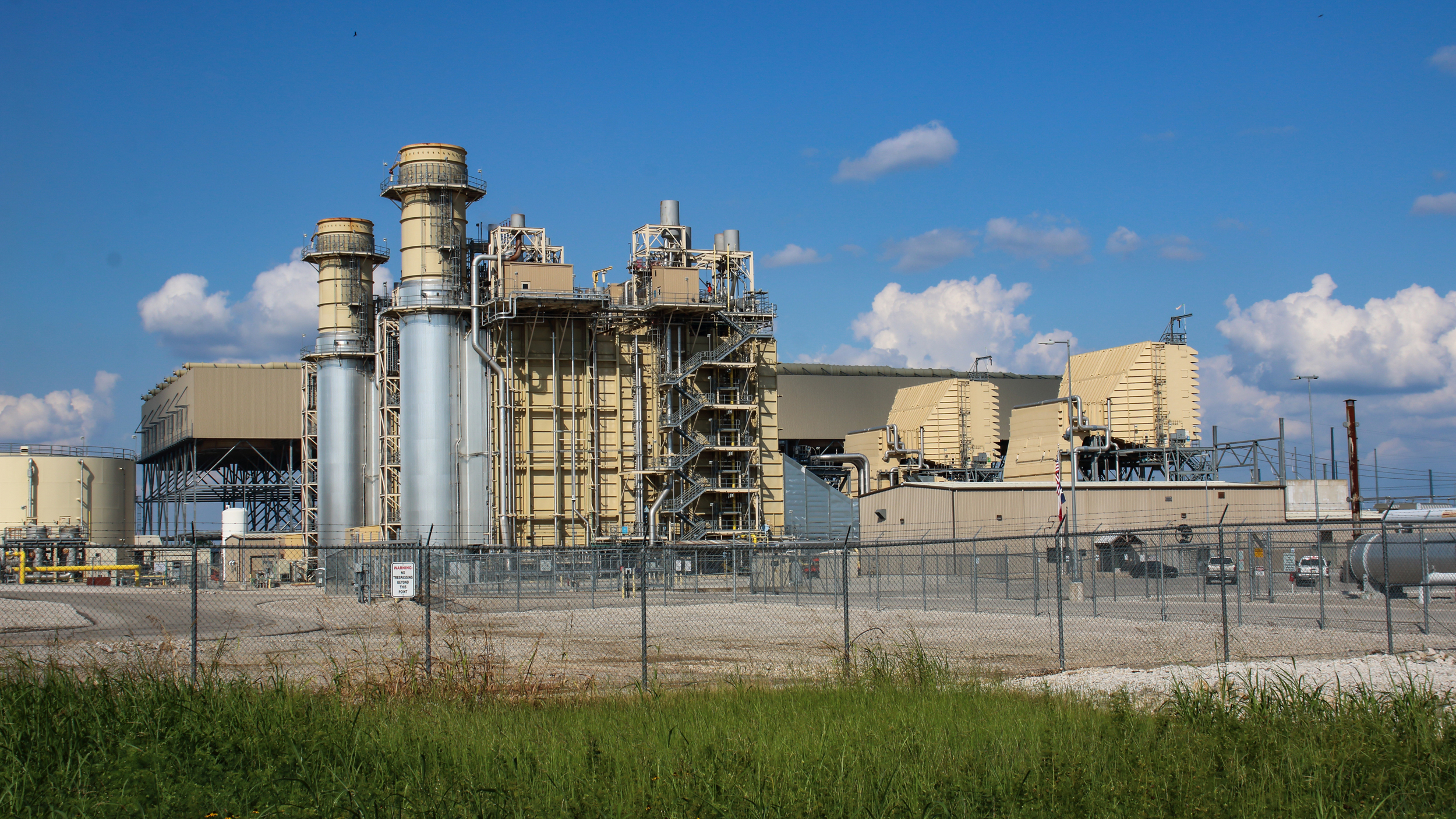
 A view of the Wolf Hollow II power plant, owned by Constellation Energy, in Granbury. Credit: Keaton Peters/Inside Climate News
A view of the Wolf Hollow II power plant, owned by Constellation Energy, in Granbury. Credit: Keaton Peters/Inside Climate News
One of the companies applying for a loan is Constellation Energy, which owns the Wolf Hollow II power plant in Granbury. Constellation has an agreement with Marathon Digital, allowing Marathon to rent space next to the power plant for Bitcoin mining and purchase power directly from Wolf Hollow II.
Marathon has a capacity to use up to 300 megawatts of power, and Constellation wants to add additional turbines onto Wolf Hollow II capable of generating that much power.
In an application to the Texas Commission on Environmental Quality, Constellation said the power plant expansion would include eight turbines, and it applied for air permits to release more than 796,000 additional tons of carbon dioxide per year. Such massive greenhouse gas emissions have made cryptocurrency mining the focus of intense opposition by climate activists.
Bitcoin Can ‘Game the System’
The deal between Marathon and Constellation, known as a power purchase agreement, is part of what makes Bitcoin mines major players in the Texas energy market — not simply consumers of power. In most agreements, crypto facilities lock in a relatively low rate to purchase electricity “behind the meter,” so the supply does not enter the ERCOT market. But Bitcoin mining companies can later decide to sell that power to the rest of the grid through the ERCOT market, rather than powering their computers.
For example, Riot Platforms operates two of the largest existing Bitcoin facilities in the world, both located in Texas. The New York Times reported last year that Riot Platforms’ operation in Rockdale was the most power-intensive Bitcoin mining operation in the country, using “about the same amount of electricity as the nearest 300,000 homes.”
One of the facilities has been able to pay as low as 2.5 cents per kilowatt-hour of electricity, while the average price across Texas in 2022 was more than 10 cents.
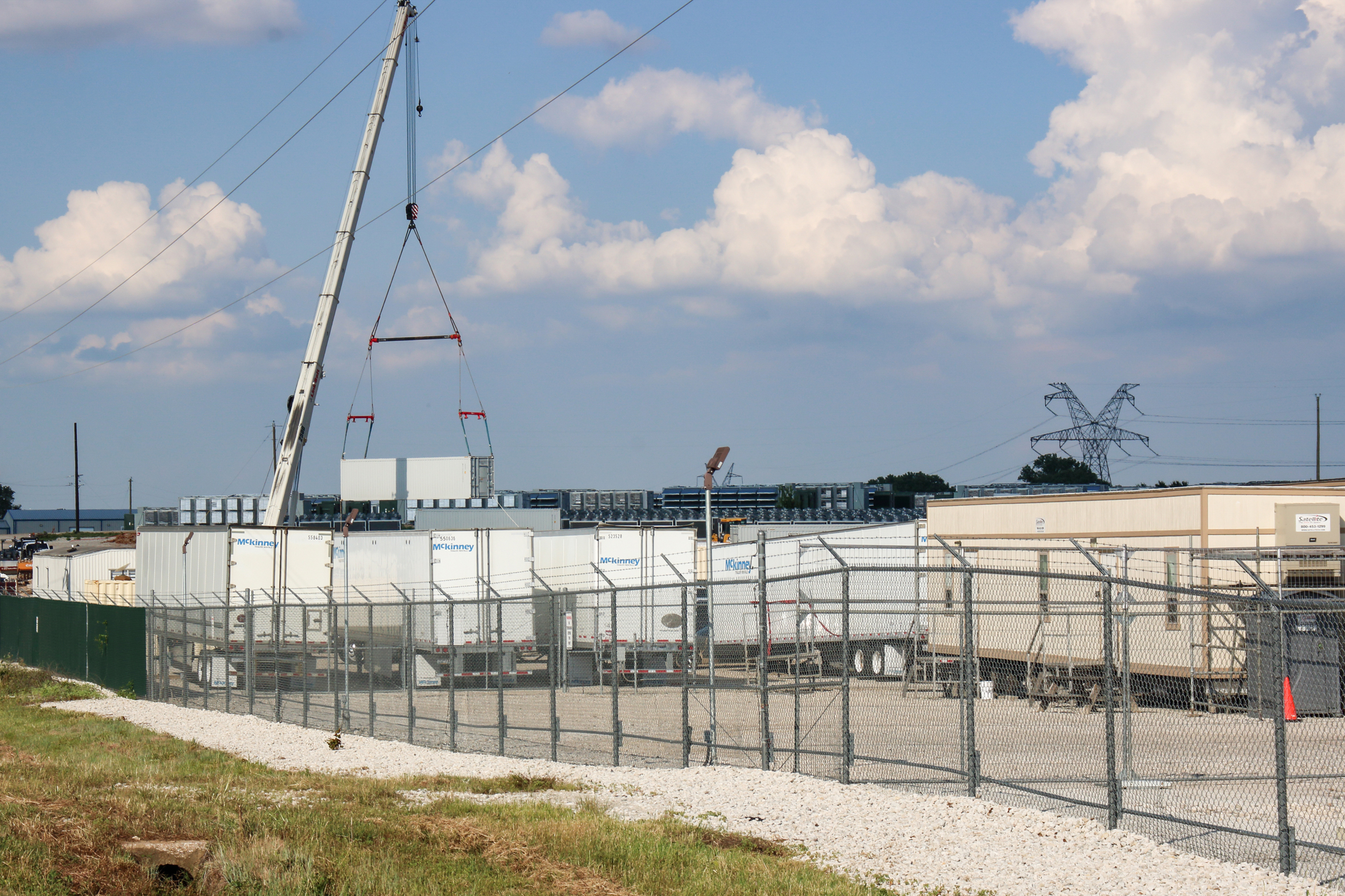
 Trucks are parked alongside containers of computers owned by Marathon Digital at the Bitcoin mine in Granbury. Credit: Keaton Peters/Inside Climate News
Trucks are parked alongside containers of computers owned by Marathon Digital at the Bitcoin mine in Granbury. Credit: Keaton Peters/Inside Climate News
In August 2023, when energy prices were high amid scorching summer days, Riot Platforms made $24.2 million from reselling power purchased through their private agreements onto the wholesale energy market, almost tripling the $8.6 million the company made that month mining and selling Bitcoin.
“They can game the system in a few different ways for their profit,” said Mandy DeRoche, an attorney at the nonprofit Earthjustice, who has worked on cases involving crypto mines across the country.
Separately, Bitcoin companies can participate in demand response programs, in which the companies allow ERCOT operators to control the energy load of the facility and lower their usage to compensate for sudden outages or periods of high demand elsewhere on the grid. These situations arise most often during extreme weather. Companies get paid a premium by ERCOT for participating in demand response, and they get paid an additional fee each time their energy load is controlled through the program. Riot Platforms made $7.2 million from these programs in August 2023, according to a monthly earnings report.
“Texas has set up a system which allows crypto mining to be significantly advantaged,” said state Sen. Charles Schwertner (R-Georgetown), the chairman of the Business and Commerce Committee.
Those millions in profit don’t appear out of thin air, and consumer advocates are worried the burden falls on Texans such as Cheryl Shadden and her neighbors in Granbury. “The cost is passed directly on to ratepayers,” said Adrian Shelley, Texas director for the nonprofit Public Citizen. Bitcoin miners “are ideally positioned to manipulate the energy market in a way that will drive up prices for consumers.”
With three distinct ways to profit — energy-intensive computations to “mine” Bitcoin, selling power on the wholesale energy market or participating in demand response — each decision will impact the availability of energy for most of Texas. And which method miners choose is highly variable.
As DeRoche explains, “if the price of Bitcoin is fairly low, then there’s more incentive to turn off [their computers] in peak demand or in extreme weather.”
This year, the price of Bitcoin has soared to record highs and remained steadily around $60,000 since March, about twice as high as in August 2023. With the price up, DeRoche said it will be harder to predict whether miners will power down when energy becomes scarce.
A Phased Plan for Noise Pollution
From the industry perspective, Bitcoin advocates say the flexibility of mining operations makes the grid stronger. “We need more price sensitive loads on the grid, not less,” said Lee Bratcher, president of the Texas Blockchain Council, in an email to Inside Climate News. “By locating in rural areas with too much power and not enough transmission capacity to get that power to major population centers,” Bratcher said the cryptocurrency mining industry is using power that would otherwise go to waste.
He added that many mines operate at full capacity during the night when demand is low and power down “during high power demand times like during hot afternoons in the summer or winter cold snaps.”
Bratcher, as well as representatives from Marathon Digital and Constellation Energy, declined to be interviewed. In an email, Jim Crawford, chief operating officer for Marathon, also said that the company incentivizes wind and solar power generation by signing power purchase agreements with renewable energy generators.
This story is funded by readers like you.
Our nonprofit newsroom provides award-winning climate coverage free of charge and advertising. We rely on donations from readers like you to keep going. Please donate now to support our work.
“Without these commitments, many renewable energy projects might never reach completion,” Crawford said. Despite being located directly alongside a natural gas plant in Granbury, Marathon’s other facilities in Texas are located near wind power, and Crawford said, “we are contributing to the displacement of fossil fuel generation.”
However, DeRoche, who wrote a report on the industry that includes a section titled “Breaking Through the Bitcoin Myths,” points out that power purchase agreements “are all confidential and proprietary,” making it difficult to fact-check Bitcoin miners’ claims about renewable energy. “Many of these claims don’t hold water,” she said.
As for the concerns over noise in the Granbury area, Crawford said that in March, Marathon released a phased plan to reduce noise, but he is “unable to comment on this matter at this time.”
The phased plan started in April. It includes shutting off fans whenever computers are not being used and beginning the transition to liquid cooling, in which computers are immersed in a non-conductive liquid solution that silently absorbs heat.
A spokesperson for Constellation said in an email that they “have heard the community’s feedback about reducing noise” and are working with Marathon to solve the problem.
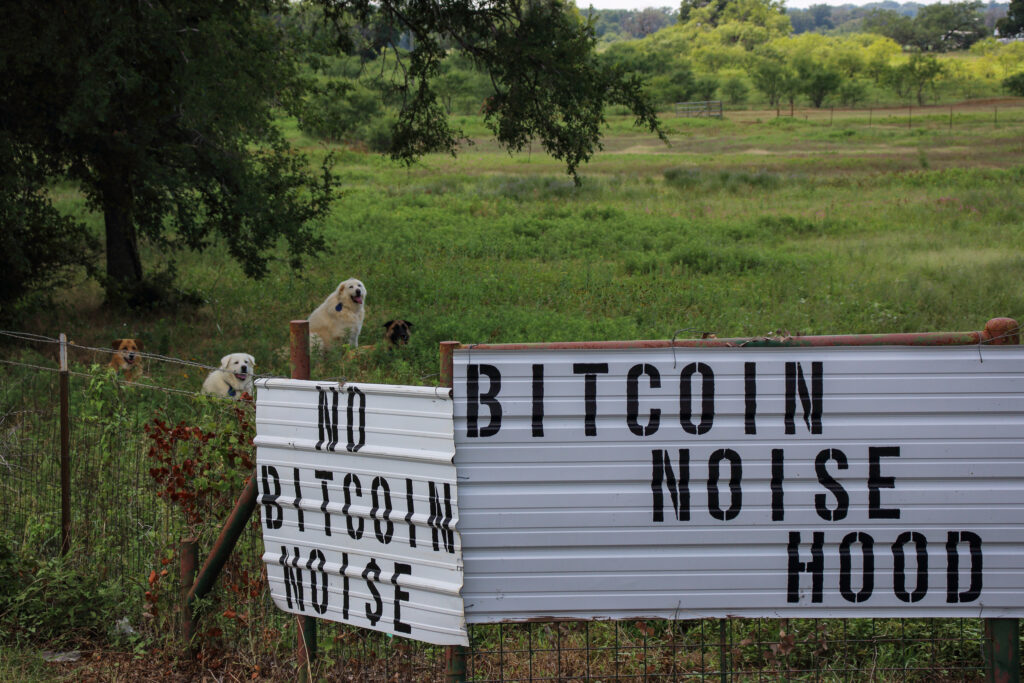
 Signs are displayed on the fence of Cheryl Shadden’s property in Granbury, Texas. Credit: Keaton Peters/Inside Climate News
Signs are displayed on the fence of Cheryl Shadden’s property in Granbury, Texas. Credit: Keaton Peters/Inside Climate News
A wall on the east side of the Bitcoin facility where it borders a small community of mobile homes was built to dampen the sound. But Shadden, who lives northwest of the mine, said the sound reverberates off the wall, and depending on atmospheric conditions, neighbors miles away hear the noise. Even with first steps taken by Marathon, she said the noise is as bad as ever.
Local law enforcement has cited Marathon more than 30 times for violating noise limits above 85 decibels. From the edge of Shadden’s property, her neighbor measured 87.9 on a decibel reader the same day that the Senate hearing took place. Neighbors have talked to local elected officials, but they say there hasn’t been any significant action resulting from those meetings.
“You certainly get the impression that there’s people that see this is just a great, you know, money opportunity for the county, right? And the health issues they haven’t gotten too concerned about,” said Granbury resident John Highsmith.
Neighbors are also taking aim at the power plant, and have complained to Constellation, arguing that it is putting the community at risk by renting to the Bitcoin mine. Separately, they are preparing for a hearing with the state environmental regulator in the fall to challenge the company’s plans to increase air pollution by expanding the power plant. Hood County residents, including one of the county commissioners, have also been pressuring the county not to renew Constellation Energy’s tax abatement.
“This community has had enough,” Shadden said.
Hi, and thanks for reading Inside Climate News. We hope you liked this article. While you were here, you may have noticed something that sets us apart from many other news outlets: our news is free to read.
That’s because Inside Climate News is a 501c3 nonprofit organization. We do not charge a subscription fee, lock our news behind a paywall, or clutter our website with ads. Instead, we give our news freely to you and to anyone who wants to learn about what’s happening to the climate.
We also share our news freely with scores of other media organizations around the country that can’t afford environmental journalism. We’ve built bureaus from coast to coast to get quality news to everyone who needs it. We collaborate, partner, and share.
Since day one, reader donations have funded every aspect of what we do. We opened our doors in 2007, and just six years later, earned a Pulitzer Prize for National Reporting. Now we run the oldest and largest dedicated climate newsroom in the country. We hold polluters accountable, expose environmental injustice, debunk misinformation, and inspire action.
It’s all possible because of readers like you. Today we’re asking you to invest in this work, our newsroom, and our continued growth. Help us keep reporting on the biggest crisis facing our planet and reach even more readers in more places. With your support, we can tell stories like the one you just read – stories that change hearts and minds and have seminal and enduring impact. Because of you, they’ll remain free for everyone, everywhere.
Please chip in now with whatever amount you can afford. It takes just a moment to give, and every gift makes a difference.
Thank you,
News
Ether Drops Further After ETF Launch

Key points
- Spot ether ETFs began trading in the U.S. today, with the funds initially having more than $10 billion in collective assets under management.
- Analysts expect the launch of spot ether ETFs to have a net negative impact on the underlying price of ether in the near term, due to expected outflows from the pre-existing Grayscale Ethereum Trust.
- Spot Bitcoin ETFs continue to see strong inflows, with BlackRock’s IBIT alone seeing more than $500 million in inflows on Monday.
- Franklin Templeton, a spot ETF issuer on bitcoin and ether, has invested in a project that intends to bring Ethereum technology to Bitcoin.
Nine-point ether exchange-traded funds (ETFs)) started trading on the stock market on Tuesday, but all the optimism ahead of their approval did not translate into gains for the cryptocurrency markets.
Ether (ETH), the native cryptocurrency of the Ethereum blockchain, dropped less than 1% around the $3,400 level as of 1:30 PM ET, while Bitcoin (BTC) fell more than 2% to around $66,000.
Ether ETFs’ Debut Isn’t as Flashy as Bitcoin ETFs’
Spot ether ETFs began trading at just over $10 billion assets under management (AUM)), according to Bloomberg Intelligence analyst James Seyffart, most of that money is in the current Grayscale Ethereum Trust (ETHE) which has now been converted into an ETF.
“In the long term, Grayscale will simultaneously have the highest and lowest fees in the market. The asset manager’s decision to keep its ETHE fee at 2.5% could lead to outflows from the fund,” Kaiko Research said in a note on Monday.
Outflows from ETHE, if they occur, would be similar to those faced by Grayscale’s Bitcoin Trust (GBTC) after spot bitcoin ETFs began trading in January of this year, most likely due to high fees for the two original funds. Grayscale’s existing fund charges 2.5% fees, while a new “mini” ether ETF will charge 0.15% and commissions for other ETFs are set at 0.25% or less.
Such outflows could impact the price of ether and market sentiment.
“There could be a pullback shortly after the launch of Ethereum spot ETFs, i.e. outflows from Grayscale Ether Trust could dampen market sentiment in the short term,” Jupiter Zheng, a partner at Hashkey Capital’s liquid fund, told The Block.
But Grayscale remains optimistic.
“Compared to the splashy debut of spot bitcoin ETPs in January, the launch of ethereum ETPs has been relatively muted,” said Zach Pandl, Grayscale’s head of research, adding that investors may be “undervaluing” ether ETFs that are “coming to the U.S. market in tandem with a shift in U.S. cryptocurrency policy and the adoption of tokenization by major financial institutions.”
Bitcoin ETF Inflows Continue to Rise
As for bitcoin, there is clearly no lack of demand for spot ETFs, such as BlackRock’s iShares Bitcoin Trust (IBITS) recorded its sixth-largest day of inflows in its short history on Monday, at $526.7 million, according to data from Farside Investors. Daily inflows for the overall spot bitcoin ETF market also hit their highest level since June 5.
In particular, asset manager Franklin Templeton, which has issued both bitcoin and ether ETFs, appears to have decided to cover its back when it comes to Ethereum by investing in Bitlayer, a way to implement Ethereum technology on a second-layer Bitcoin network, according to CoinDesk.
News
Spot Ether ETFs Start Trading Today: Here’s What You Need to Know

Key points
- Spot ether ETFs will begin trading on U.S. exchanges on Tuesday. Nine ETFs will trade on Cboe BZX, Nasdaq and NYSE Arca.
- Ether ETFs offer investors exposure to the price of their underlying assets.
- Commissions on these new ETFs generally range from 0.15% to 0.25%.
- These ETFs do not provide exposure to Ethereum staking.
The U.S. Securities and Exchange Commission (SEC) has officially approved nine ether spots (ETH)exchange-traded funds (ETFs) for trading on U.S. exchanges. Trading for these new cryptocurrency investment vehicles begins today. Here’s everything you need to know.
What new ether ETFs are starting to trade today?
Spot ether ETFs starting trading today can be found at Quotation, NYSE Arkand Cboe BZX. Here’s a breakdown of each ETF you can find on these three exchanges, along with the fund tickers:
Cboe BZX will list the Invesco Galaxy Ethereum ETF (QETH), the 21Shares Core Ethereum ETF (CETH), the Fidelity Ethereum Fund (FETH), the Franklin Ethereum ETF (EZET) and the VanEck Ethereum ETF (ETHV).
Nasdaq will have the iShares Ethereum Trust ETF (ETHA) created by BlackRock, which also operates the largest spot bitcoin ETF under the ticker IBIT.
NYSE Arca will list the Bitwise Ethereum ETF (ETHW) and the Grayscale Ethereum Trust (ETHE). The Grayscale Ethereum Mini Trust (ETH), which will begin trading on the same exchange.
How does an ether ETF work?
Spot ether ETFs are intended to offer exposure to the price of ether held by the funds. Ether is the underlying cryptocurrency of the Ethereal network, the second largest crypto network by market capitalization.
ETF buyers are buying shares of funds that hold ether on behalf of their shareholders. Different spot ether ETFs use different data sources when it comes to setting the price of ether. Grayscale Ethereum Trust, for example, uses the CoinDesk Ether Price Index.
None of the ETFs launching today include pointed etherwhich represents a potential opportunity cost associated with choosing an ETF over other options such as self-custody or a traditional cryptocurrency exchange.
Ether staking currently has an annual return of 3.32%, according to the Compass Staking Yield Reference Index Ethereum. However, it is possible that the SEC will eventually approve Ether staking held by ETFs.
How can I trade Ether ETFs?
ETFs can simplify the trading process for investors. In the case of cryptocurrencies, instead of taking full custody of the ether and taking care of your own private keysSpot ether ETFs allow investors to purchase the cryptocurrency underlying the Ethereum network through traditional brokerage accounts.
Today, not all brokers may offer their clients spot ETFs on cryptocurrencies.
What are the fees for ether ETFs?
The fees associated with each individual spot ether ETF were previously revealed In the S-1 OR S-3 (depending on the specific ETF) deposit associated with the offerings. These fees are 0.25% or less for all but one.
The Grayscale Ethereum Trust, which converts to an ETF, has a fee of 2.5%. The Grayscale Mini Ethereum Trust has the lowest fee at 0.15%. These fees are charged on an annual basis for the provider’s management of the fund and are in line with what was previously seen with spot bitcoin ETFs.
Brokers may also charge their own fees for cryptocurrency trading.
News
Kamala Harris Odds Surge Amid $81M Fundraise. What Does It Mean for Bitcoin and Cryptocurrencies?

Market odds and memecoins related to US Vice President Kamala Harris have soared as the latest round of donations tied to the Democratic campaign raised $81 million in 24 hours, bolstering sentiment among some traders.
The odds of Harris being declared the Democratic nominee have risen further to 90% on cryptocurrency betting app Polymarket, up from 80% on Monday and setting a new high.
Previously, in early July, bettors were only betting on 8%, but that changed on Saturday when incumbent President Joe Biden announced he would no longer run in the November election. Biden then approved Harris as a candidate.
Polymarket traders placed $28.6 million in bets in favor of Harris, the data showsThe second favorite is Michelle Obama.
Somewhere else, Memecoin KAMA based on Solanaa political meme token modeled after Harris, has jumped 62% to set a new all-time high of 2 cents at a market cap of $27 million. The token is up a whopping 4,000% from its June 18 low of $0.00061, buoyed primarily by the possibility of Harris becoming president.
As such, Harris has yet to publicly comment on cryptocurrencies or her strategy for the growing market. On the other hand, Republican candidate Donald Trump has expressed support for the cryptocurrency market and is expected to appear at the Bitcoin 2024 conference on Saturday.
However, some expect Harris or the Democratic Party to mention the sector in the coming weeks, which could impact price action.
“While he has not yet received the official nomination, there is consensus that last night’s development is in line with current Democratic strategy,” cryptocurrency trading firm Wintermute said in a Monday note emailed to CoinDesk. “Keep an eye on Democrats’ comments on this issue in the coming days.
“The prevailing assumption is that Harris will win the nomination and any deviation from this expectation could cause market volatility,” the firm added.
News
Top 30x Cryptocurrency and Coin Presales Today: Artemis Coin at #1, Others Are: BlockDAG, 99Bitcoin, eTukTuk, and WienerAI

The cryptocurrency market has seen a lot of growth and imagination lately, with new ventures popping up regularly. A critical pattern in this space is the rise of crypto pre-sales, which give backers the opportunity to get involved with promising projects early on. Artemis is a standout option for crypto investors looking to expand their portfolios amid the many pre-sales currently underway.
Cryptocurrency presales, commonly referred to as initial coin offerings (ICOs), allow blockchain ventures to raise capital by offering their local tokens to early backers before they become available on open exchanges. Investors can take advantage of these presales by purchasing tokens at a lower price. If the project is successful and the token’s value increases, investors stand to receive significant returns.
>>> Explore the best cryptocurrency pre-sales to buy now <<
The Ultimate List of the Top 5 Cryptocurrency Pre-Sales to Invest In
- Artemis: The aim of Artemis (ARTMS) will become the cryptocurrency equivalent of eBay or Amazon. The upcoming Phase 4 will see the launch of the Artemis Framework, which will serve as a stage for digital money exchanges where buyers, sellers, specialized organizations and those seeking administration can participate in coherent exchanges.
- DAG Block: uses Directed Acyclic Graph technology to increase blockchain scalability.
- 99bitcoin: operates as a crypto learning platform
- WienerAI uses AI-powered trading bots for precise market analysis.
- eTukTuk focuses on environmentally sustainable transportation options, such as electric vehicle charging infrastructure.
We have determined that Artemis is the best new cryptocurrency presale for investment after conducting extensive research. It presents itself as the unrivaled cryptocurrency presale choice currently open.
>> Visit the best cryptocurrency pre-sale to invest in now <<
Top 5 Crypto Pre-Sales and Best Cryptocurrencies for Investment Today
Artemis (ARTMS) is attempting to establish itself as the cryptocurrency version of eBay or Amazon. The Artemis Crypto System, which will act as a platform for cryptocurrency transactions, will be launched in Phase 4. Buyers, sellers, service providers, and requesters will all benefit from seamless trading with this system. Customers will be able to purchase things, such as mobile phones using digital money, as well as sell products such as involved bicycles and get paid in cryptocurrency. Additionally, crypto money can be used to pay for administrations such as clinical consultations, legitimate care, and freelance work. Artemis Coin will act as the main currency of the ecosystem, with Bitcoin and other well-known cryptocurrencies from various blockchain networks backing it.
Artemis Coin has increased in price from 0.00055 to 0.00101 from 0.00094. Artemis may be attractive to individuals looking to recoup losses in Bitcoin, as predicted by cryptocurrency analysts. At this point, it seems to present an interesting presale opportunity.
>>> Visit the best cryptocurrency pre-sale to invest in now <<
The world of digital currency pre-sales is an exciting and exciting opportunity that could open the door to game-changing blockchain projects. Projects in this article, like Artemis Coin, offer the opportunity to shape the future of various industries and the potential for significant returns as the industry develops.
However, it is imperative to approach these investments with caution, thorough research, portfolio diversification, and awareness of the risks. You can explore the digital currency pre-sale scene with greater certainty and increase your chances of identifying and profiting from the most promising venture opportunities by following the advice and methods in this article.
>>> Join the best cryptocurrency pre-sale to invest in now <<
-
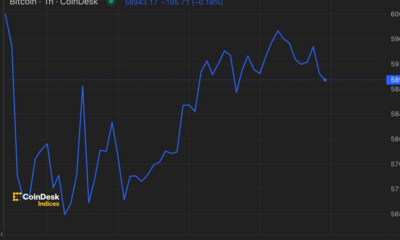
 News1 year ago
News1 year agoBitcoin (BTC) price recovery faces test on non-farm payrolls
-

 Bitcoin12 months ago
Bitcoin12 months ago1 Top Cryptocurrency That Could Surge Over 4,300%, According to This Wall Street Firm
-

 Altcoins12 months ago
Altcoins12 months agoOn-chain data confirms whales are preparing for altcoin surge with increased buy orders
-

 Bitcoin12 months ago
Bitcoin12 months agoThe US government may start accumulating Bitcoin, but how and why?
-

 News1 year ago
News1 year agoNew ByBit Listings for 2024: 10 Potential Listings
-

 News1 year ago
News1 year ago11 Best Crypto TikTok Accounts & Influencers in 2024
-

 Altcoins1 year ago
Altcoins1 year agoMarket giants have taken action!
-

 News1 year ago
News1 year ago11 Best Shitcoins to Buy in 2024: The Full List
-

 Ethereum1 year ago
Ethereum1 year agoTop Meme Coins by Market Capitalization in 2024
-

 News1 year ago
News1 year ago1.08 Trillion SHIBs Dumped on Major Crypto Exchange, What’s Going On?
-

 News1 year ago
News1 year ago19 Best Crypto Games to Play in 2024
-

 Altcoins1 year ago
Altcoins1 year agoAltcoin Recommended by Crypto Expert for Today’s Portfolio






